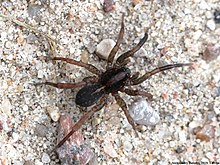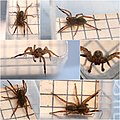Aardwolf spider
| Aardwolf spider | ||||||||||||
|---|---|---|---|---|---|---|---|---|---|---|---|---|

Aardwolf spider ( Trochosa terricola ), female |
||||||||||||
| Systematics | ||||||||||||
|
||||||||||||
| Scientific name | ||||||||||||
| Trochosa terricola | ||||||||||||
| Thorell , 1856 |
The Erdwolfsspinne or Common Evening wolf spider ( Trochosa terricola ) is a web spider from the family of wolf spiders (Lycosidae).
features
The females of the aardwolf spider reach a body length of 10 to 14 millimeters, males one of eight to ten. The basic color of the species is mostly brown with a reddish tone. Like the other representatives of the genus Trochosa , the aardwolf spider also has a light longitudinal ligament on the prosoma , which has a bulge in the front half. Inside each of these there are two black vertical stripes. The opisthosoma has a lighter skewer spot and behind it several angular spots and lighter pairs of points. A definite distinguishing feature from other species of the genus is the lack of a claw on the tip of the probe in the male.
Similar species
The seven species of the genus Trochosa , T. hispanica , T. hungarica , T. ochracea , T. robusta , T. ruricola , T. spinipalpis and T. terricola are difficult to distinguish from each other. A determination in the field succeeds mainly in the males, since the sex organs are very similar in the females themselves. The species have slightly different demands on their habitat .
Occurrence
The aardwolf spider inhabits all of Europe and parts of Asia , including Eastern Siberia , China and Japan . It prefers dry to moderately moist biotopes with partial shade or full light. Such habitats form forest clearings and edges as well as dry grasslands . The aardwolf spider can be found frequently within its range and is therefore not classified as threatened.
Way of life

Like all wolf spiders, the aardwolf spider is predominantly crepuscular and nocturnal. During the day it can also be observed occasionally, but is often hidden under stones or dead wood. This is where the spider digs its living tube, which it likes to stay in during the daytime.
Catching prey
The spiders do not build their own nets, but roam around in search of food. Prey, mostly other arthropods of suitable size, are caught in a surprise attack, as is usual with wolf spiders, before the spider injects its venom. The aardwolf spider is often captured by females of the spring wasp and other species of the genus Anoplius . These wasps are parasitoids and use the spiders, which were previously paralyzed with a sting, as food supplies for their offspring.
Reproduction
The mating season for the aardwolf spider is in spring. During mating, which takes several hours, the male rises on the female's back and takes turns inserting his bulbs into the female's epigyne . Some time after mating, the female creates its cocoon , which contains around 100 eggs, inside its living tube and attaches it to the spinnerets like other wolf spiders. The hatched young animals climb onto the opisthosoma of the female and stay there until the first molt. The life expectancy of the aardwolf spider is two years. While the females can be found all year round, the males are particularly active in spring and into autumn.
Systematics and taxonomy
When it was first described in 1856 by T. Thorell , the spider received its current scientific name Trochosa terricola from the description . In 1861 the spider was placed in the genus Lycosa by Niklas Westring , but was again accepted as a trochosa after 1959 .
gallery
Individual evidence
- ↑ a b c d e Heiko Bellmann: The cosmos spider leader. Over 400 species in Europe. Kosmos Naturführer, Kosmos (Franckh-Kosmos), 2nd edition, 2016, p. 184, ISBN 978-3-440-14895-2 .
- ↑ Trochosa terricola in the Arachnological Society's Spider Forum Wiki, accessed on May 23, 2019
- ↑ a b c d e Description of the aardwolf spider on www.natur-in-nrw.de ( Link )
- ↑ AS Schljachtenok: About the prey spiders (Aranei) of some wasps (Hym., Pompilidae). Entomological News and Reports, 40, 3, pp. 169–172, 1996 ( PDF, German )
- ↑ T. Thorell : Recensio critica aranearum suecicarum quas descripserunt Clerckius, Linnaeus, de Geerus. Nova Acta Regiae Societatis Scientiarum Upsaliensis, 3, 2 (1), pp. 61-176, 1856.
- ↑ Niklas Westring: svecicae Araneae. Göteborgs Kungliga Vetenskaps och Vitterhets Samhälles Handlingar, 7, pp. 1-615, 1861.
- ↑ The aardwolf spider in the World Spider Catalog ( Link )
literature
- T. Thorell : Recensio critica aranearum suecicarum quas descripserunt Clerckius, Linnaeus, de Geerus. Nova Acta Regiae Societatis Scientiarum Upsaliensis, 3, 2 (1), pp. 61–176, 1856 ( facsimile of the first description, Latin ).




